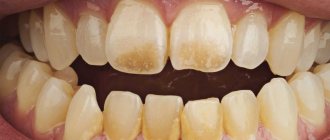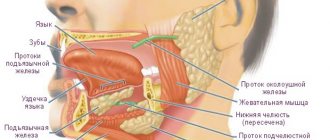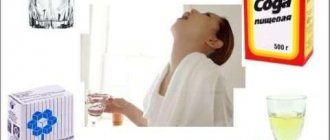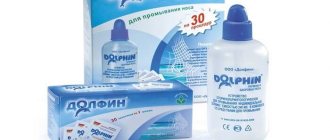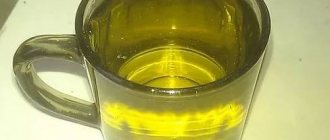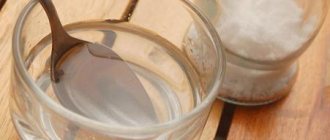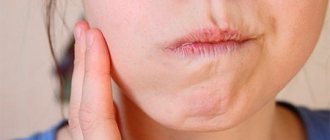Bactericidal effect for health recipes, is it possible to rinse your mouth with salt
- In practice, sea salt is used for gums; it is rich in trace elements and minerals, and can also be useful for chewing elements. It has bactericidal properties, which means it can easily wash away unwanted microorganisms on the mucous membrane. Rinsing your mouth with sea salt creates conditions that are not natural for microorganisms, depriving the viability of bad bacteria. In addition, the product, diluted in boiled water, will reduce the pain reaction of both the gums and the sensitivity of the chewing elements.
If you rinse your mouth with salt water, the effect appears very quickly. The inflammatory reaction of the gums is reduced, and pain in the teeth is reduced. The effect lasts for a long time.
Soda salt and iodine for throat
You can not only purchase sea salt at the pharmacy, but you can also prepare a mixture similar in properties to it yourself. To do this you will need the following ingredients:
- warm water – 2 tbsp.;
- salt – 0.5-1 tsp;
- iodine – 2-3 drops;
- baking soda (sodium bicarbonate) – 0.5-1 tsp.
We suggest you familiarize yourself with washing the tonsils at home: how to clean the tonsils
These components just need to be mixed - the rinsing solution is ready. It is recommended to use it 4-5 times a day. The product should not be too hot, just above body temperature. So it will be pleasant for the mucous membranes. If after such rinses a dry cough appears, then you should switch to medicinal decoctions of herbs, for example, chamomile, sage or calendula.
Strengthening teeth with sea salt
Salt will help strengthen your teeth. It prevents decay processes, and, therefore, removes bad breath and heals gums. In addition, there are also good effects from using salt; salt whitens enamel and eats away tartar.
You can also use table salt for oral care. But sea salt will be more effective. It is rich in trace elements and minerals that have a beneficial effect on teeth and gums. Elements such as iron, nickel, phosphorus, sodium, calcium, silicon, magnesium and potassium play an important role in strengthening the gums. Sea salt contains manganese and iodine, and its bactericidal properties are higher than those of table salt.
It has long been noticed that those who love salty foods are less likely to suffer from diseases of the gums and teeth. From time immemorial, the Chinese have been brushing their teeth with sea salt and do not have caries. In 1674, the Dutch scientist Leeuwenhoek discovered the existence of microbes and, in parallel, discovered that sea salt could destroy microbes. The scientist saw a large number of microbes in the wash from his own teeth. Then, as an experiment, the scientist Leeuwenhoek took a cloth, previously soaked in a saline solution, and wiped his teeth with it. These microbes were no longer present in the new flush. Leeuwenguk lived a long life, and died at 93; he always brushed his teeth only with sea salt.
Beneficial properties of sea salt
Sea salt will relieve swelling and numb the affected area. This remedy will also disinfect the throat and reduce inflammation, which will reduce the healing process and alleviate unpleasant symptoms. In addition, salt removes mucus and pathogenic bacteria from the throat that cause coughing. The effect of the solution is aimed at removing excess fluid from cells and tissues, as a result of which swelling decreases.
Sea salt is obtained naturally. Its chemical structure includes a huge amount of minerals and trace elements. Such as: iodine, magnesium, calcium, manganese, phosphorus, aluminum, zinc, iron, sulfur, potassium, silicon, fluorine, copper. These elements have significant advantages in human life:
- sodium potassium - ensures the metabolic process in the body and improves water balance;
- phosphorus - this element serves to restore damaged cells and tissues;
- selenium – relieves the oxidative process and revives cellular structures;
- calcium – serves for instant regeneration of tissue cells;
- magnesium – stimulates the absorption of microelements.
Sea salt also has positive results in nourishing cells, relieves depression, helps heal wounds, strengthens the immune system, treats runny nose and sinusitis.
Sea salt is ideal for treating any disease associated with viruses, as the salt has a unique antiseptic property.
It can cure diseases such as:
- Purulent sore throat. With this disease, gargling is one of the main procedures. The solution perfectly washes out pus and dead cells from the tonsils and back wall of the throat, eliminates the inflammatory process and relieves pain.
- Purulent pharyngitis is also treated with this method.
- Laryngitis - saline solution is used as an adjuvant.
Method of strengthening teeth with sea salt
Take a glass of warm water and dissolve 1 tsp in it. salt. Brush your teeth and rinse your mouth with a salt solution. You can use fine sea salt instead of expensive toothpastes.
Dip a wet toothbrush into the salt. Then brushing your teeth follows the usual pattern. If you are hesitant to switch to sea salt instead of toothpaste, then we can advise you to brush your teeth with toothpaste in the morning and brush your teeth with salt in the evening. Then the disinfecting effect of sea salt will last until the morning.
How to make a saline gargle
An important component of a saline solution is liquid. It is strictly forbidden to use tap water that has not been purified. It includes chlorine, which only irritates the mucous membrane of the throat and mouth. The liquid should be:
- warm, feeling closer to hot, but not burning;
- suitable for drinking - boiled or filtered drinking;
- cooler for children, because they sense temperature differently.
In addition to the correct liquid, it is important to maintain its proportions with salt. Taking this into account, the solution is prepared according to the following instructions:
- take a glass of warm boiled water (200 ml);
- add 0.5 tsp. salt;
- stir, let stand for 5-10 minutes if the crystals have not dissolved;
- if there are still large particles left, then it is worth straining the solution so as not to scratch the oral mucosa.
To strengthen teeth
It does not need to be chewed, diluted with purified drinking water and rinsed for 1 minute. You need to rinse your mouth every time after brushing your teeth.
While on vacation at sea, you can rinse your mouth right in the sea, and not just near the shore. Swim further, fill your mouth with sea water and hold it. Spit, fill your mouth with water again and rinse your mouth. A week after these salt rinses, your teeth will become stronger.
You can take care of your teeth at home, but you should definitely visit the dentist twice a year, even for preventive purposes.
Our blog VKontakte
←
SUBSCRIBE
there is a lot of interesting things)
Friends,
if you like the article, then like, subscribe to the channel and share with your friends on social networks so as not to miss the latest publications. Thank you!
* all information is for informational purposes only. Before purchasing a drug or treatment, consult a specialist
How often can you gargle?
The rinsing process should be carried out 3-4 times a day, lasting 2-3 minutes. In this case, 200 ml of the product should be used for each procedure. The duration of use of this method depends on how quickly the patient recovers. Indicators of duration are: disappearance of soreness, restoration of the mucous membrane, elimination of ulcers.
For prevention, this procedure must be continued for another 2-3 days, while rinsing 1-2 times a day. It is advisable that the solution gets into the nasopharynx, since there remain pathogenic bacteria that need to be fought.
After gargling, it is not recommended to eat or drink for thirty minutes.
You need to use only a fresh solution; with prolonged storage, all the beneficial properties disappear.
Some patients believe that frequent rinsing is the way to a quick recovery. This opinion is erroneous, since salt can not only heal, but can also aggravate the situation. If you gargle frequently, your throat may dry out, as well as cracks in the larynx and the penetration of microbes.
Sea salt is the best gargle. Rules of application
Hello, my dear readers! We have already talked about baths with the gift of the seas, now I would like to remember the wonderful healing properties of sea salt. Gargling with sea salt helps get rid of bad breath, destroys infection in case of sore throat and other diseases of the throat or teeth.
Another plus is that the solution is harmless and suitable even for small children. If they swallow a little salt water, there will be no harm to their health.
From this article you will learn:
Gargling with sea salt - recipes for use
Useful properties and chemical composition of sea salt
Sea salt is formed by nature and only by nature.
Therefore, production, to be precise, is not such a thing.
It is evaporated from sea water rather than produced under natural conditions. Once collected, the white crystals are purified.
As a rule, this is where human intervention ends - no other additional processing is applied in the future.
Chemical composition of sea salt
The composition depends on the place and time of extraction.
There are some salts that contain up to 92 microelements that the body needs, of which the most necessary are:
These elements are vital for a person trying to cure a sore throat, as well as toothache from inflammation or after tooth extraction. Thanks to them, the throat is disinfected, as well as the destruction of viruses and bacteria.
Benefits of salt water rinsing
Seawater rinses can be effective in treating certain conditions.
Angina
Rinsing with sea water is an effective way to relieve discomfort from a sore throat. Doctors recommend gargling with salt water to relieve a sore throat. Regular rinsing with sea water can prevent infections, especially in people undergoing chemotherapy or radiation therapy.
Stomatitis
Stomatitis can cause painful ulcers in the mouth. Rinsing your mouth with salt water can relieve pain and help sores heal.
Allergy
Some allergic reactions, such as hay fever, can cause swelling in the nose and throat. While gargling with salt water won't prevent allergies, it can relieve some sore throats.
Respiratory infections
Upper respiratory tract infections include colds, influenza, mononucleosis and sinusitis. Gargling with salt water can relieve symptoms and even prevent upper respiratory infections. A study of 338 people found that those who gargle with salt water were less likely to have upper respiratory infections.
Dental health
Regular salt water rinsing will help remove bacteria from your gums and prevent the buildup of plaque and tartar. Bacteria in the mouth can lead to gum disease and tooth decay.
How to prepare a sea salt solution for gargling?
Solution concentration and required proportions
A cup of warm water (200.0) mixed with a quarter to a half teaspoon of sea salt is a good solution for deep gargling. It is important to use this concentration to avoid dehydration.
How often should you gargle with sea salt?
But in terms of quantity, you should gargle or gargle as much as needed, or at least several times a day.
What temperature should the solution be?
Although warm water is most often used, its temperature may vary from case to case. And this must be taken into account.
For example, when gargling to reduce inflammation in the throat or gum area, it is better to use a solution at a temperature slightly higher than body temperature. And for toothache, on the contrary, it’s a little cooler.
You need to be very careful when using water that is close to hot in temperature. A burn to the mucous membrane is not the most pleasant result of our treatment, believe me.
Rinsing your mouth with a soda-salt solution for toothache: proportions, how to prepare
It has long been known that toothache is one of the most unpleasant. Sometimes it occurs at the most inopportune moment, for example, at night, when going to the clinic is simply impossible. That is why folk remedies made from improvised ingredients are often used to solve such dental problems.
A real salvation from toothache can be rinsing your mouth with a solution based on soda and salt. The benefits of salt water have been known for a long time - this simple drug effectively disinfects the oral cavity, helps relieve swelling and pain. This and other popular mouthwashes will be discussed in the article.
Why is it useful to rinse your mouth with a soda-saline solution?
The soda-salt mixture does not treat diseases of the teeth, mucous membranes of the oral cavity and gum diseases such as caries, gingivitis, and periodontal disease. However, this handy remedy can help a person out if he has a toothache or swollen gums, but for some reason it is currently impossible to get to the dentist.
Baking soda (sodium bicarbonate) is used not only for cleaning dirty surfaces or in culinary production. A solution based on this product is actively used for rinsing and washing the mouth and teeth. Additional ingredients in the composition of the healing product may include iodine, salt and essential oils in various proportions. In some recipes, the usual table salt is replaced with sea salt, which is more expensive and has greater benefits.
The benefits of soda and soda-salt mixtures for the health of teeth and soft tissues of the oral cavity are multifaceted. This home remedy can help solve a whole range of dental problems because:
- Has an antimicrobial effect.
- Helps prevent harmful acids from destroying tooth enamel.
- Stops the inflammatory process.
- Helps make tooth pain less painful and the patient’s condition more comfortable.
- Can help get rid of tartar and plaque.
When preparing mixtures for rinsing the mouth and performing oral baths, the ingredients should be measured in strict accordance with the proportions recommended in the recipes in order to avoid burns of the oral mucosa, damage to the integrity of the enamel and other painful reactions.
Contraindications to rinsing with soda-saline solution
A soda-salt solution for mouth rinsing, made in the correct proportions, is not capable of having a significant harmful effect. However, for some diseases and individual characteristics, a healing folk remedy can cause considerable harm to the patient’s health.
Young children should not rinse their mouths with soda-based products, even with severe toothache. Children under 3–4 years old do not yet understand the essence and technique of the procedure and can swallow a significant amount of liquid, which is why it is better to dip a cotton or gauze swab into the medicinal composition and help the baby treat the mucous membranes of the oral cavity by simply wiping.
The drug may cause harm if you have a traumatic brain injury, brain disease, or a predisposition to stroke. In addition, you can significantly worsen your health if you take it orally.
If a person is diagnosed with thyroid dysfunction, nephritis or tuberculosis, he should not add iodine to salt water. The same rule applies to pregnant and lactating women. You should not overuse mouth rinsing with soda, salt or iodine based mouthwash for nausea and vomiting.
Rules for preparing a soda-salt solution
A saline solution with soda for rinsing a sore tooth is prepared as follows: take a glass of moderately warm water (27–30 °C), and place 1 tsp in it. salt and soda, after which the bulk ingredients are stirred until completely dissolved. When the product is ready, rinse your mouth thoroughly for 1-2 minutes.
You can do it even simpler: take 200 ml of heated water and dilute 1 teaspoon of sodium chloride in it.
It is necessary to rinse your mouth immediately after diluting the ingredients, since cooled water can have the opposite effect, increasing pain.
Recipes for other mouth rinses
Any adult can prepare a solution of soda and salt for rinsing the mouth for tooth pain, since the necessary ingredients are available in almost every kitchen. But you need to keep in mind that to rinse your mouth for toothache, you can only use a fresh mixture of soda and water . You should not dilute large amounts of soda for future use.
Traditional medicine offers a huge number of recipes for solutions for rinsing the mouth, which include table or sea salt, iodine, hydrogen peroxide, and infusions of medicinal herbs.
If your tooth hurts
To eliminate toothache, you can use salt, soda and iodine. If a tooth hurts badly, it is useful to rinse it with diluted soda with the addition of these ingredients to enhance the healing effect. To properly make and use a healing home remedy, use these simple recommendations:
- Before rinsing your mouth, you must thoroughly clean your teeth to remove dirt and food debris.
- When preparing a liquid from salt, soda and iodine for rinsing a diseased tooth, the following proportions must be observed: 1 tsp. bulk substances, 2–3 drops of iodine component, 1 glass of moderately warm water.
- There is no need to use too cold or hot water to prepare the medicine, as it can aggravate the patient’s condition. Cold liquid can make your tooth ache even more, and boiling water can seriously injure your gums.
- You should especially carefully rinse your mouth with diluted soda with salt and iodine in the area where toothache is felt.
- In the process of rinsing a diseased tooth, portions of the soda-saline solution should be changed every 0.5 minutes, the total duration of the procedure is at least 4–5 minutes.
- The medicine should not be taken orally; after rinsing, the liquid should be spat out.
- There is no need to rinse your mouth with salt or iodine liquid after use.
- When preparing a product from salt, soda and iodine to relieve tooth pain in a child over 5 years old, different proportions should be used: 0.5 tsp per standard glass of water. salt and soda and one drop of iodine. It is important to explain to your baby what will happen if you take this product orally, and why the rinse solution must be spat out.
- The medicinal liquid must be diluted and used at least three times a day - after each meal. Reducing the interval will not help increase the effect.
Frequent use of aggressive rinsing solutions can cause harm in the form of drying out the mucous membranes of the oral cavity, increasing the sensitivity of the enamel and other negative consequences.
If your gums are inflamed
Soda solutions are useful for inflammation of the soft tissues of the oral cavity. The fact is that such folk remedies have an enhanced antibacterial effect, help prevent the development of infection, and reduce pain. For the same reason, this drug is used to treat the throat for sore throat, ARVI and other colds and infectious diseases.
To prepare a high-quality oral rinse, you need to properly dilute the ingredients. The proportions will be the same as when making a medicinal mixture to relieve tooth pain: 1 tsp. soda per 200 ml of warm water. The finished product will help reduce the activity of inflammation and also make the teeth a little whiter.
To increase the effectiveness of the soda remedy, you can use it not to rinse sore gums, but as a bath. And add 2-3 drops of iodine to it. To enhance the disinfecting effect, you can use not water, but a warm sage decoction.
Why is regular salt replaced with sea salt?
Some dentists advise taking baths and rinsing sore teeth with a solution of baking soda and sea salt. The fact is that this product contains an increased amount of iodine, which has an antimicrobial effect. In addition, this salt helps strengthen tooth enamel.
To prepare a healing solution for tooth pain, you need to take 1 tsp. soda and sea salt and dilute them with 250 ml of warm water. To strengthen the enamel of teeth, it is enough to rinse sensitive teeth with a mixture containing 1 small spoon of bulk product and half a glass of water.
To weaken the effect of pathogenic microbes living in the oral cavity and remove heavy odor, you can rinse your mouth with a solution of soda and hydrogen peroxide. To make the medicine, take 250 ml of heated water and add 3 tbsp. l. 3% peroxide and 1 tbsp. l. sodium bicarbonate without a slide. The mixture is thoroughly stirred and used for therapeutic rinsing of the mouth. It is not recommended to take the drug internally or use it for any other therapeutic purposes.
Despite the beneficial properties of salt, iodine and soda, medicinal mixtures based on them can only be used as first aid or auxiliary treatment. If acute pain or inflammation occurs, you should contact your dentist as soon as possible and begin therapy aimed at eliminating the cause of the disease.
Sources: https://stomaget.ru/bolezni/zubov/poloskanie-ot-zubnoj-boli-sodoj-i-solyu https://stomaget.ru/bolezni/zubov/poloskanie-ot-zubnoj-boli-sodoj-i -solyu https://stomaget.ru/bolezni/zubov/zub-reagiruet-na-holodnoe-i-goryachee
Healthy Recipes with Sea Salt
- Sea salt for sore throat
Sea salt helps neutralize acids, restoring the pH balance in the throat area, thus relieving pain and burning.
Salt dissolves excess mucus and speeds up the healing process by normalizing blood flow.
Gargling with a warm saline solution can help relieve cough pain and dry throat symptoms associated with pharyngitis or sore throat.
At the same time, harmful bacteria are drawn out of the swollen tissues and an obstacle is created for the growth of new ones. Adding baking soda to the rinse solution will also benefit.
Another effective recipe for tonsillitis: dissolve a teaspoon of salt and soda in water, add one drop of iodine.
- Sea salt for toothache
Another benefit of using sea salt is toothache relief.
In addition, after this procedure it promotes healing and cleansing of the area where the tooth used to be after it was removed. And rinsing will slow down bleeding in this place, disinfecting the wound and speeding up healing.
Sea salt contains many beneficial substances that are also found in teeth.
Therefore, such regular rinses are very beneficial for teeth.
They are even better and more effective than using industrial dental elixirs.
Stomatitis and other painful infections are less likely to occur with regular use of saline solution. Stopping bleeding from the gums, eliminating harmful bacteria located between the tooth and gum - factors that are very easy to eliminate with rinsing.
As a result, the gums become stronger and are able to return to their normal color.
This also serves as a good prevention of periodontal disease.
Salt naturally stimulates the production of saliva, which is known to destroy harmful bacteria in the mouth. As a result, it not only helps fight infections, but also freshens breath.
Soda and salt solution
The disinfecting effect of the solution will increase if you add a little soda to sodium chloride. This component also has the ability to relieve unpleasant symptoms in the throat, and not only in the case of heartburn. For purulent forms of sore throat and pharyngitis, soda locally destroys the infection and dries out the mucous membrane. In this case, preparing a rinse means following the following instructions:
- Dissolve 1 tsp in a glass of water. salt;
- add 0.25 tsp. soda, mix everything well;
- check if all ingredients are dissolved in water.
If for an adult patient it is necessary to increase the effectiveness of rinsing, then it is necessary to increase the dosage of ingredients. The proportions will change slightly: for 1 teaspoon of salt you will have to take 0.5 tsp. soda If dryness is observed after the procedure, then it is worth reducing the concentration of the main components to the standard one. This recipe using baking soda is for adults only.
Rules for rinsing teeth with salt for toothache
If you follow the rules of rinsing, you can neutralize the manifestations of pain during the first hour . The frequency of the procedure should be at least 5-6 times .
Peculiarities:
- The solution is kept near the diseased tooth for as long as possible - from 30 seconds to 2 minutes .
- The duration of rinsing should last 5-7 minutes .
Important! Even if the result is positive and the acute pain has completely passed, you should consult a dentist for a full examination and sanitation.
Against the backdrop of pain:
- Limit food intake.
- Pre- clean your teeth to remove food debris.
- Before rinsing, carefully remove food debris from the cavity of the diseased tooth and interdental spaces.
Attention! highly recommended not to make any warm compresses or take antibiotics without a doctor's prescription.
Recipes for saline solutions with water proportions
Dentists recommend using a saline solution to relieve acute pain before seeking treatment from a doctor. There are several effective recipes:
- Salt. For 1 glass of heated water, 1 tbsp is required. l. Dilute thoroughly until completely dissolved . Rinse the mouth frequently.
- Combined with soda. Add to 200 ml of water . l. salt and soda . The rinse aid becomes richer and stronger.
- Mixture with iodine. Dissolve in 1 glass of water at 38-40 °C . l. powder _ Add 2-3 drops of Lugol . Disinfect the oral cavity.
- With an admixture of herbs. Brew plantain, chamomile, and sage in equal proportions . Add 1 tbsp. l. salt _
To prepare a healing solution , use any salt available in the house:
- Cooked.
- Marine.
- Iodized.
Rinsing your mouth with a soda-salt solution for toothache: proportions, how to prepare
It has long been known that toothache is one of the most unpleasant. Sometimes it occurs at the most inopportune moment, for example, at night, when going to the clinic is simply impossible. That is why folk remedies made from improvised ingredients are often used to solve such dental problems.
A real salvation from toothache can be rinsing your mouth with a solution based on soda and salt. The benefits of salt water have been known for a long time - this simple drug effectively disinfects the oral cavity, helps relieve swelling and pain. This and other popular mouthwashes will be discussed in the article.
Why is it useful to rinse your mouth with a soda-saline solution?
The soda-salt mixture does not treat diseases of the teeth, mucous membranes of the oral cavity and gum diseases such as caries, gingivitis, and periodontal disease. However, this handy remedy can help a person out if he has a toothache or swollen gums, but for some reason it is currently impossible to get to the dentist.
Baking soda (sodium bicarbonate) is used not only for cleaning dirty surfaces or in culinary production. A solution based on this product is actively used for rinsing and washing the mouth and teeth. Additional ingredients in the composition of the healing product may include iodine, salt and essential oils in various proportions. In some recipes, the usual table salt is replaced with sea salt, which is more expensive and has greater benefits.
The benefits of soda and soda-salt mixtures for the health of teeth and soft tissues of the oral cavity are multifaceted. This home remedy can help solve a whole range of dental problems because:
- Has an antimicrobial effect.
- Helps prevent harmful acids from destroying tooth enamel.
- Stops the inflammatory process.
- Helps make tooth pain less painful and the patient’s condition more comfortable.
- Can help get rid of tartar and plaque.
When preparing mixtures for rinsing the mouth and performing oral baths, the ingredients should be measured in strict accordance with the proportions recommended in the recipes in order to avoid burns of the oral mucosa, damage to the integrity of the enamel and other painful reactions.
Contraindications to rinsing with soda-saline solution
A soda-salt solution for mouth rinsing, made in the correct proportions, is not capable of having a significant harmful effect. However, for some diseases and individual characteristics, a healing folk remedy can cause considerable harm to the patient’s health.
Young children should not rinse their mouths with soda-based products, even with severe toothache. Children under 3–4 years old do not yet understand the essence and technique of the procedure and can swallow a significant amount of liquid, which is why it is better to dip a cotton or gauze swab into the medicinal composition and help the baby treat the mucous membranes of the oral cavity by simply wiping.
The drug may cause harm if you have a traumatic brain injury, brain disease, or a predisposition to stroke. In addition, you can significantly worsen your health if you take it orally.
If a person is diagnosed with thyroid dysfunction, nephritis or tuberculosis, he should not add iodine to salt water. The same rule applies to pregnant and lactating women. You should not overuse mouth rinsing with soda, salt or iodine based mouthwash for nausea and vomiting.
Rules for preparing a soda-salt solution
A saline solution with soda for rinsing a sore tooth is prepared as follows: take a glass of moderately warm water (27–30 °C), and place 1 tsp in it. salt and soda, after which the bulk ingredients are stirred until completely dissolved. When the product is ready, rinse your mouth thoroughly for 1-2 minutes.
You can do it even simpler: take 200 ml of heated water and dilute 1 teaspoon of sodium chloride in it.
It is necessary to rinse your mouth immediately after diluting the ingredients, since cooled water can have the opposite effect, increasing pain.
Recipes for other mouth rinses
Any adult can prepare a solution of soda and salt for rinsing the mouth for tooth pain, since the necessary ingredients are available in almost every kitchen. But you need to keep in mind that to rinse your mouth for toothache, you can only use a fresh mixture of soda and water . You should not dilute large amounts of soda for future use.
Traditional medicine offers a huge number of recipes for solutions for rinsing the mouth, which include table or sea salt, iodine, hydrogen peroxide, and infusions of medicinal herbs.
If your tooth hurts
To eliminate toothache, you can use salt, soda and iodine. If a tooth hurts badly, it is useful to rinse it with diluted soda with the addition of these ingredients to enhance the healing effect. To properly make and use a healing home remedy, use these simple recommendations:
- Before rinsing your mouth, you must thoroughly clean your teeth to remove dirt and food debris.
- When preparing a liquid from salt, soda and iodine for rinsing a diseased tooth, the following proportions must be observed: 1 tsp. bulk substances, 2–3 drops of iodine component, 1 glass of moderately warm water.
- There is no need to use too cold or hot water to prepare the medicine, as it can aggravate the patient’s condition. Cold liquid can make your tooth ache even more, and boiling water can seriously injure your gums.
- You should especially carefully rinse your mouth with diluted soda with salt and iodine in the area where toothache is felt.
- In the process of rinsing a diseased tooth, portions of the soda-saline solution should be changed every 0.5 minutes, the total duration of the procedure is at least 4–5 minutes.
- The medicine should not be taken orally; after rinsing, the liquid should be spat out.
- There is no need to rinse your mouth with salt or iodine liquid after use.
- When preparing a product from salt, soda and iodine to relieve tooth pain in a child over 5 years old, different proportions should be used: 0.5 tsp per standard glass of water. salt and soda and one drop of iodine. It is important to explain to your baby what will happen if you take this product orally, and why the rinse solution must be spat out.
- The medicinal liquid must be diluted and used at least three times a day - after each meal. Reducing the interval will not help increase the effect.
Frequent use of aggressive rinsing solutions can cause harm in the form of drying out the mucous membranes of the oral cavity, increasing the sensitivity of the enamel and other negative consequences.
If your gums are inflamed
Soda solutions are useful for inflammation of the soft tissues of the oral cavity. The fact is that such folk remedies have an enhanced antibacterial effect, help prevent the development of infection, and reduce pain. For the same reason, this drug is used to treat the throat for sore throat, ARVI and other colds and infectious diseases.
To prepare a high-quality oral rinse, you need to properly dilute the ingredients. The proportions will be the same as when making a medicinal mixture to relieve tooth pain: 1 tsp. soda per 200 ml of warm water. The finished product will help reduce the activity of inflammation and also make the teeth a little whiter.
To increase the effectiveness of the soda remedy, you can use it not to rinse sore gums, but as a bath. And add 2-3 drops of iodine to it. To enhance the disinfecting effect, you can use not water, but a warm sage decoction.
Why is regular salt replaced with sea salt?
Some dentists advise taking baths and rinsing sore teeth with a solution of baking soda and sea salt. The fact is that this product contains an increased amount of iodine, which has an antimicrobial effect. In addition, this salt helps strengthen tooth enamel.
To prepare a healing solution for tooth pain, you need to take 1 tsp. soda and sea salt and dilute them with 250 ml of warm water. To strengthen the enamel of teeth, it is enough to rinse sensitive teeth with a mixture containing 1 small spoon of bulk product and half a glass of water.
To weaken the effect of pathogenic microbes living in the oral cavity and remove heavy odor, you can rinse your mouth with a solution of soda and hydrogen peroxide. To make the medicine, take 250 ml of heated water and add 3 tbsp. l. 3% peroxide and 1 tbsp. l. sodium bicarbonate without a slide. The mixture is thoroughly stirred and used for therapeutic rinsing of the mouth. It is not recommended to take the drug internally or use it for any other therapeutic purposes.
Despite the beneficial properties of salt, iodine and soda, medicinal mixtures based on them can only be used as first aid or auxiliary treatment. If acute pain or inflammation occurs, you should contact your dentist as soon as possible and begin therapy aimed at eliminating the cause of the disease.
Thursday salt treatment
The product has an antiseptic and cleansing effect and strong energy. Once in the inflamed area, salt draws out exudate , depriving bacteria of their habitat. At the same time, the solution washes away all germs and pieces of food that serve as a source of inflammation.
Photo 1. Quaternary salt is black in color, since table salt, in addition to sodium chloride, contains various impurities and when calcined, a chain of chemical reactions occurs, externally manifested in the blackening of the composition.
Preparation
Thursday salt is prepared only once a year . According to the Orthodox calendar, the date falls on Holy Week on Maundy Thursday . Made in the morning.
You will need:
- 1.5 kg rock salt.
- 200 g rye flour.
- Cast-iron pan.
Step-by-step instruction:
- Heat a clean, dry frying pan.
- Pour in salt and 12 tbsp. l. flour _
- constantly clockwise using a wooden spoon.
- Heat the mixture until completely blackened .
Reference! During calcination, they read “Our Father” three times or say a special prayer “Maundy Thursday” .
more useful if you cook it with medicinal herbs . Plants used for this
- nettle;
- mint;
- Melissa;
- rosemary;
- oregano.
Components can be changed and combined . Plant materials are crushed , bread is moistened with water . Everything is mixed . Heat the mixture until it turns black.
Did you cure it?
Due to its improved properties, Thursday salt helps to effectively cope with toothache. Has a disinfecting effect and sanitizes the oral cavity. Solution composition:
- 200 ml warm water.
- 1 tbsp. l. black Thursday salt.
Treatment is carried out frequently: every 15-20 minutes for the first two hours .
Quarter salt is a safe, proven mouth irrigant. It can be used without fear . The pain subsides after the first rinse . At the same time, microbes and fungi that live in dental plaque die. is whitened .
Recipes for rinses
In addition to simply brushing your teeth with salt alone or adding it to the toothpaste, you can use various recipes for rinsing. In some cases, they help cleanse the enamel, in others - strengthen it, sometimes to eliminate toothache or even whiten. We list the most popular of them:
- Add 2 tsp to a glass of warm water. sodium chloride (salt) and stir it well.
- To reduce the unpleasant reaction to salt water, you can add a teaspoon of baking soda. This proportion is maintained until the sensitivity of the teeth goes away completely.
- If you add 2-3 drops of iodine to the previous ingredients, you will get an excellent disinfectant.
- Instead of table salt, you can use sea salt, then add a tablespoon of the product to a glass of water, and expect a whitening effect from the result.
- If you dilute 2-3 tbsp in 200 ml of warm water. l. vodka and 1 tsp. table salt, you will also get a good disinfecting solution that eliminates all pathogenic bacteria on the surface of the gums and enamel. But here you need to be careful not to damage the mucous membrane.
Instead of warm water, as a base, you can use decoctions of medicinal herbs - chamomile, sage, mullein, oak bark, string, strawberry, raspberry, mint, rose petals, calamus, St. John's wort or linden. Let's describe these recipes in more detail:
- For 1 spoon of chamomile take 2 tbsp. l. sage and 3 tbsp. l. mullein Pour a glass of boiling water over this mixture and leave until it cools to room temperature. Add a little salt to the finished strained product and use it as a rinse.
- Take 1 spoon of oak bark, pour boiling water and boil in a water bath for at least 20 minutes. Let the broth brew for another 40 minutes, add salt. After straining the solution, it can be used as a rinse in cases of painful sensations in the teeth and bleeding gums.
- Take dry herbs in the following proportions - one part each of strawberry, raspberry, and string leaves and two parts of mint. Pour boiling water over the product and leave for about an hour until it cools down. After straining the product, add 1 tsp. table salt, stir well and use as a medicinal rinse up to 10 times a day.
- The following herbs have a good effect - rose petals, plantain and medicinal chamomile. If you take these dry substances in equal proportions and pour boiling water over them, allowing them to brew for enough time, you can expect a good disinfectant, soothing and even analgesic effect in the area of the affected tooth.
- Linden leaves, St. John's wort and calamus have proven themselves well. You can prepare them similarly to the previous recipe.
All these remedies help not only to cleanse the oral cavity of plaque, tartar, food debris and pathogens, but also to eliminate inflammation of the gums and relieve pain in the affected tooth. The main thing is not to get carried away with this method as a treatment option. In any case, you need to visit a dentist to eliminate the root cause of the disease.
If you use cleaning the tooth surface with salt as a hygienic and preventative measure, then you can expect that the enamel and gums will always be in a healthy state and you will not need to eliminate pain or be treated by a dentist at all.
Risks of self-medication
Saline solution is an emergency measure. Treatment tactics depend on the underlying pathology . The causes of toothache are serious enough to warrant self-medication.
Soreness can be caused by deep caries with penetrating infection, pulpitis , periodontitis . With the help of salt it can relieve pain , but not cure the disease. The bacterial infection will continue to destroy tooth tissue.
Possible complications:
- Dying of nerves.
- Abscess or abscess .
- Osteomyelitis.
- Phlegmon.
- Progression of caries .
Important! In case of acute toothache, contact the dentist on the first day . They don't wait for the attack to happen again.

